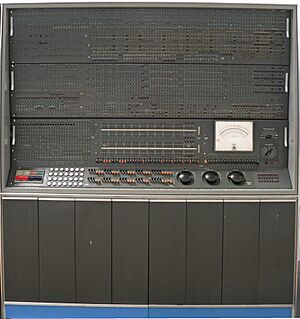Emily Willbanks facts for kids
Quick facts for kids
Emily Willbanks
|
|
|---|---|
| Born |
Emily West
November 25, 1930 |
| Died | February 18, 2007 (aged 76) |
| Nationality | American |
| Education | B.S. degree from Duke University and Master's degree from the University of New Mexico |
| Occupation | Mathematician, Physicist, Computer Scientist |
| Employer | Los Alamos National Laboratory |
| Known for | Work in weapons applications and high performance and data storage systems |
| Spouse(s) | Eugene Willbanks |
| Parents |
|
Emily Willbanks was a brilliant scientist who worked at the Los Alamos National Laboratory for many years. She was born Emily West on November 25, 1930, and passed away on February 18, 2007. Emily made big improvements in math, computers, and how we store information. She used her knowledge of physics and math to help with defense projects and create super-fast data storage systems. She even helped a major weather center in England!
Contents
Emily's Life Story
Early Years and School
Emily West was born in Fort Lauderdale, Florida, on November 25, 1930. Her dad, Frank M. West, managed a private beach estate. Her mom was a homemaker. Emily was their only child.
From a young age, Emily loved math and science. She went to public high school. In 1948, she started studying science at Duke University. After her first year, she won a scholarship for being an excellent student.
Emily was the only female physics major in her graduating class. She earned a bachelor's degree in math and physics in 1952. She then continued her studies at the University of New Mexico. There, she completed a master's degree in physics in 1957.
Starting Her Career
Before joining Los Alamos, Emily worked at Pratt & Whitney Aircraft Co. This was from 1952 to 1954. She was an engineering aide in mathematics.
Her job involved doing hand calculations. She figured out how heat moved and how liquids flowed. This was for a study on planes powered by nuclear energy. She worked with General Electric on this project.
Working at Los Alamos National Laboratory
Emily West started working at the Los Alamos National Laboratory in 1954. At first, she did many calculations by hand. Later, she began working with the MANIAC I computer. This computer was used for projects related to defense.
She worked in the weapons division until the early 1970s. After that, she joined the Computer Division. She worked there until she retired in 1990. Her work involved designing and keeping computer storage systems running.
One big project was designing a special computer storage system. This system helped organize and store important data. She also helped computerize information for defense projects. She even adapted this software for a weather center in England.
Personal Life
Emily met Eugene Willbanks at Los Alamos. She worked in the weapons department. Eugene worked in the computing division.
They got married in 1959. They did not have any children. Eugene passed away in 1994. Emily Willbanks died on February 18, 2007, in Los Alamos, New Mexico.
Emily's Big Projects
Helping with Defense Projects
At the Los Alamos National Laboratory (LANL), Emily Willbanks (then Emily West) worked with a small team. They used special computer code to study defense designs. These designs were created by engineers at LANL.
Their analysis produced data from computer simulations. This data helped engineers make better designs. Emily was key in checking this data. She made sure it was correct and found important patterns.
This work helped improve defense designs. It also allowed for different types of tests. Most of the computer code was done on a powerful machine called the IBM 7030 Stretch. Emily's physics background helped her understand the technical terms.
Improving Data Storage Systems
After working on defense projects, Emily Willbanks started a new challenge. She worked on improving LANL's data storage systems. This was very important because LANL could not buy the storage systems they needed.
For twelve years, Emily and a team of six or seven people worked on this. They created a super-fast data storage system called the Clustered File System (CFS). It was designed to store a lot of information safely.
One challenge was keeping up with fast-changing computer software. Each time storage devices were updated, Emily had to create new ways for the data to work with them. The system also had to meet different user needs. Some needed to protect secret information. Others needed to share data easily.
Emily helped design the CFS to organize various types of information. It also handled different security levels. The CFS system later became available for others to use. This led to Emily helping a weather center in England. The CFS system was very useful for defense calculations and weather data.
Helping England's Weather Centre
When the Clustered File System (CFS) software became public, England's weather center asked for help. They needed Emily's expertise to use and update the software. The center was near London.
Emily helped them with regular upgrades and maintenance. Their data was stored on different types of computers over time. These included Control Data, Cray, and Fujitsu machines. Eventually, they switched to a commercial IBM model.
Emily's hard work led to the use of the Meteorological Archival and Retrieval System (MARS). This system helped them collect huge amounts of weather data. This included observations, forecasts, and data from big research projects.


